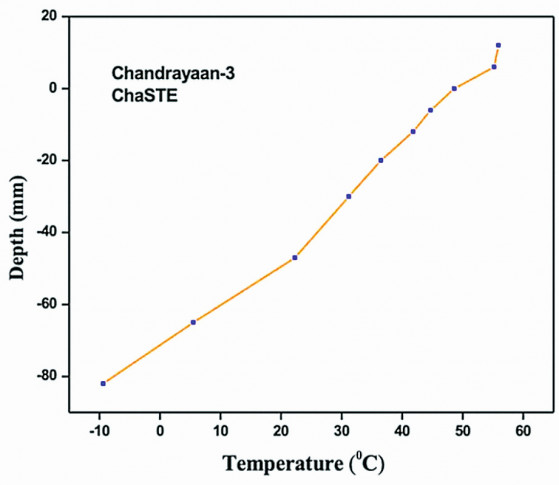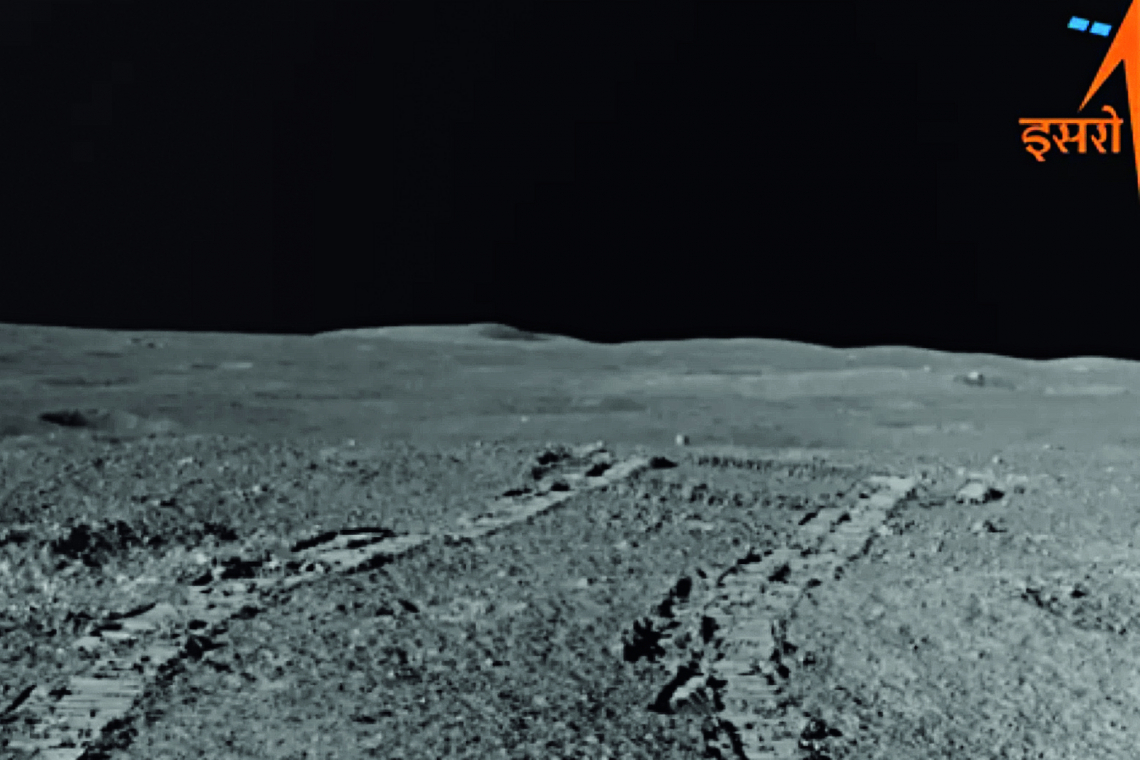The soft landing of the Indian space probe "Chandrayaan-3" ("Chandra" = the moon; "Yaan" = means of transport) on the south pole of the Earth's satellite on August 23, 2023 was widely reported in the media. This success makes India the fourth country ever to successfully send a space probe to the moon. Particularly noteworthy is the fact that the South Pole has hardly been explored so far. During the unmanned mission, the Indian Space Research Organization (ISRO), headquartered in Bengaluru, was able to conduct two weeks of research and find out more information about frozen water on the moon, among other things. The six-wheeled lunar vehicle "Pragyaan" (= wisdom) was able to drive more than 100 meters and even successfully completed a "bounce" test.
The Pragyaan was able to provide data on the properties of lunar soil and rock, including chemical and elemental compositions, over a period of two weeks. Ten temperature sensors were used to measure the temperature profile of the lunar crust.
The lander Vikram ("Vikram" = brave) and the rover are equipped with various measuring instruments. The Langmuir probe was used to determine the density of charged particles. The Instrument for Lunar Seismic Activity (ILSA) was used to investigate seismic activity around the landing site. The ILSA instrument is the first instrument on the moon based on MEMS (Micro Electro Mechanical Systems) technology. It recorded the vibrations caused by the movements of the rover and other payloads. ILSA consists of a group of six highly sensitive accelerometers manufactured using the silicon micromachining process. The core element of the sensor consists of a spring-mass system with comb-like structured electrodes. External vibrations cause the spring to deflect, which leads to a change in capacitance that is converted into a voltage. In addition, an auxiliary instrument called the Laser Retroreflector Array (LRA), which belongs to the US National Aeronautics and Space Administration (NASA), is also on the moon. This lightweight structure with eight retroreflectors can serve as a long-term geodetic station and location marker on the lunar surface. The chemical composition of the lunar regolith was analyzed using two spectrometers, also with regard to material that could originate from fallen asteroids. Spectroscopic analyses revealed sulphur for the first time. Elements such as aluminum, iron, calcium, chromium, titanium, manganese, oxygen and silicon were detected on the lunar surface. The sulphur found raises new questions about the origin of the moon.
A large number of women scientists and engineers have also contributed to each of the ISRO programs. The more than 100 women employees played a direct and important role in the conception, design, realization, testing and implementation of Chandrayaan-3.
The success of the Chandrayaan-3 mission is a great incentive for aerospace R&D and industry. Such a complex high-tech project could only be made a success because of good collaboration between ISRO and Indian institutions and companies - both small and large. ISRO's main areas of research include developments in satellite technology, technological advancements in launch vehicles, material science, remote sensing, communication systems, navigation, space situational awareness, space weather and planetary science. Change in temperature on the lunar surface with increasing depth
Change in temperature on the lunar surface with increasing depth
Surface technologies and material science topics at the umbrella organization ISRO and its research institutes spread across India include the following:
- Black anodizing of aluminum 6061T6 and chromating
- Electrochromic polymer films for spacecraft temperature control
- Polymer-derived ceramic precursor technology for high entropy ceramics and UHTCs
- Conversion coatings for aerospace applications
- Thermal/plasma assisted functional coatings
- Development of coatings for IR filters
- Space-qualified flexible EMI shielding and radiation-resistant coatings and housings for on-board electronics
- Development of a dry film resist for thin-film integration on LTCC ceramics
- Development of a process for electroless silver plating on a non-cyanide basis
- Development of a process for electroless gold plating
- Metallization of composite materials to improve electrical and thermal conductivity for the development of RF components
- Generation of damage models for the prediction of defects during metal forming
- High entropy alloys as high temperature resistant oxidation coating for semi-cryogenic engines
- Development of a new thermal barrier coating to reduce the heat flux in the thrust chamber of a semi-cryogenic engine
- Development of coating materials for use in high temperature environments.
ISRO offers technology transfer in the following areas:
- Silver plating on aluminum 6061T6, Invar, copper and DMLS aluminum
- Gold plating on aluminum 6061T6, Kovar, stainless steel EN 1.4301, phosphor bronze and Ti alloys
- Electroless Ni-P, black anodizing, chromating, Al 6061T6 anodizing
- Black and white coating for thermal control
- Optically diffuse coating for integrating sphere
- Copper oxide-based black coating with high absorption capacity on Al-6061 and copper
- Integral black anodizing on magnesium alloys with silicate protective layer
- Black electroless nickel coatings with high solar absorptivity on Invar 36, and
- Aluminum with silicate protective coating
- Coating product Compound EPY1061, an epoxy-based system modified with amidoamine, specially developed to protect metal surfaces from corrosion in an aqueous strontium perchlorate medium.
Well over 200 companies such as Linde India and Tata Consulting Engineers have participated in the Chandrayaan-3 mission. India would like to sell satellite communications in the future and - like the USA - pave the way for the private sector into space. With a view to security policy, the country is also planning to develop its own regional navigation system in order to become less dependent on the US GPS system. At the equivalent of around 66 million euros, the costs of the Indian Chandrayaan-3 mission were significantly lower than comparable projects in the USA, Russia or China.
You can read more about Chandrayaan-3 in Galvanotechnik 11/2023.ex-ISRO employee Dr. Anand Sharma writes about Chandrayaan-3 and in even greater detail than here about the surface technology involved in the project.


